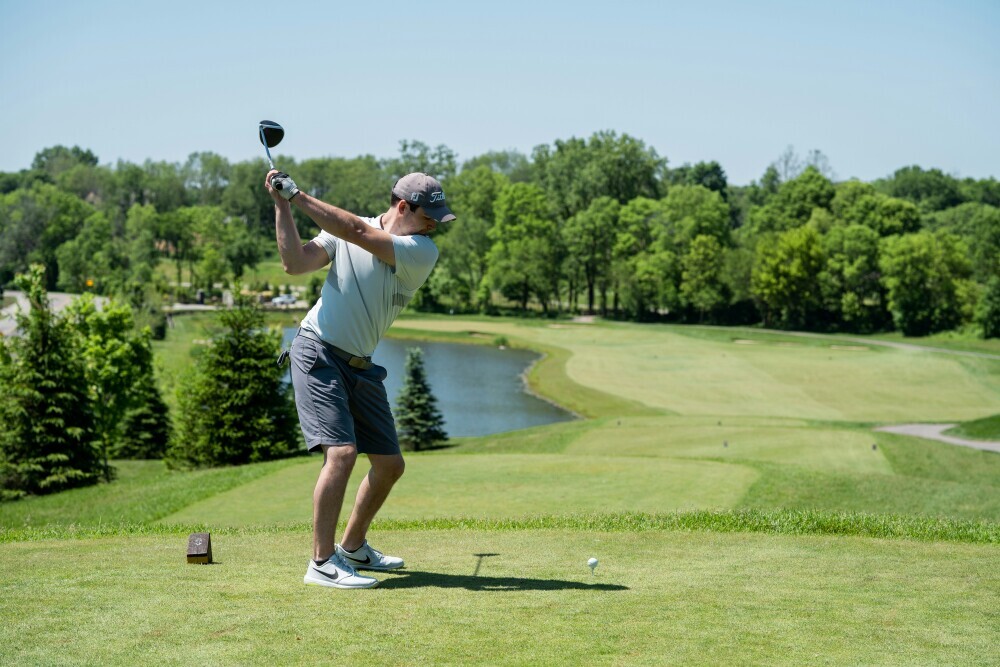Putting Backspin On Golf Ball


Fore! Quick note: a few links here are affiliate links. If you snag gear through them, I earn a small commission — no extra strokes added to your game.
Watching the pros put backspin on their shots can feel like magic. But it’s not just about raw talent; it’s a skill honed through practice and understanding. Once you understand the art behind what gives the ball backspin, you’ll be able to make some magic on the golf course yourself. This is the golf viking, and today we’re talking backspin.
Professional golfers make backspin look effortless. The way they control the ball’s movement is a blend of physics, technical skill, and lots of hard work. Understanding how they do it can help take your game to the next level. Being able to put backspin on your shots can get your ball into prime position for a birdie.
Take a look at some iconic backspin shots in golfing history. Tiger Woods’ chip-in on the 16th hole at the 2005 Masters is a prime example. That shot had just the right amount of backspin to drop into the hole dramatically. Such moments illustrate the power of mastering backspin.
Pros achieve that kind of mastery through relentless practice. They spend hours honing their technique, tweaking their swings, and understanding the nuances of their equipment. It’s about finding that perfect balance between force and finesse. Getting backspin on your ball doesn’t happen overnight.
You don’t need to be Tiger Woods to benefit from learning backspin, however. Watch how your favorite golfers practice and see what works for them. Pay attention to their grip, stance, and swing mechanics. Then, head to the range and start fine-tuning your backspin skills yourself. Let’s get into what makes backspin happen.
Adding backspin to your putts can improve control and stopping power. Learn more about green reading and speed in our guide on how to judge putting speed.
Ready to level up your golf game? Click here.

Understanding Backspin in Golf: The Basics
Backspin in golf is what makes the ball rise and then stop or even roll backward when it hits the ground. It’s all about how fast the ball spins backward in the air, and this spin affects the ball’s behavior after it lands. Getting good at backspin can shrink the ground you have to cover to get in the hole.
Let’s get science-y for a second: when a golf ball has backspin, it creates lift (just like an airplane wing). The faster the ball spins backward, the more lift it gets. This lift helps the ball climb higher and descend more steeply, giving you better control over where it ends up.
Two main factors create backspin: your swing speed and the friction between the clubface and the ball. When you hit down on the ball with a clean, sharp strike, you generate the right conditions for backspin. Of course it’s not as easy as all that.
Backspin isn’t just for show. It can make your shots more accurate and predictable. When you know how your ball will react upon landing, it becomes easier to plan your shots, especially on approaches to the green. Without it, your ball might just roll off the back of the green, leaving you with a tricky chip shot. Professional golfers spend many hours getting this down so that they can predict where they want the ball the end up.
There are common myths about backspin that need busting. One is that only pros can achieve it. Sure, they’re masters of it, but recreational golfers can learn it too with the right techniques and practice. Anybody can get backspin on their ball with enough practice.
Visual aids can boost your understanding of backspin dynamics. Slow-motion videos and high-speed photos show precisely how the ball reacts to spin. These tools can be invaluable in improving your technique. This is where proper training or having a trainer can really help your game.
The type of putter you use affects your ability to generate backspin. Check out our post on the different types of putters in golf to see which designs help with touch and control.

The Strategic Advantages of Backspin in Golf
Backspin isn’t just a neat trick; it’s a game-changer, especially when conditions call for precision and control. It can help golfers put their ball in the best position for a short putt and even help them avoid rolling off the green or avoiding a tough spot to putt from.
The main reason you want to master backspin is for better control of your ball, particularly on the greens. When you hit a shot with good backspin, the ball reacts predictably when it lands, allowing for more accurate placement. This is crucial for approach shots where you need the ball to stop quickly or even roll back a bit.
Backspin can also be a lifesaver in tricky course conditions. Thick rough, wet greens, or hard, fast greens can turn a regular shot into a gamble. With backspin, you have more control, reducing the randomness of the ball’s movement. It’s like having a tool to tame the course, giving you a little more predictability in unpredictable situations.
In your short game, backspin is your friend. Chipping and pitching with backspin can help stop the ball close to the hole, giving you more makeable putts. It can turn those nervy short shots into opportunities to save par or even make birdie. Backspin can truly alter your scorecard if done correctly.
Let’s look at some real-life scenarios. Imagine landing your ball on a downhill slope on the green. Without backspin, your ball could roll right off the putting surface. With a good amount of backspin, the ball can grip the green, slow down, and stop where you want it to. This kind of control can save you strokes and boost your confidence.
In essence, knowing when and how to use backspin strategically can make the difference between an average round and a great one. It’s a skill worth investing time in, as it can significantly improve your overall game. So how do we get that beautiful backspin?
Accuracy is key when trying to control backspin. Explore our guide on the most accurate golf putters for better line and consistency.

Achieving the Perfect Backspin: Mechanics and Techniques
Generating backspin is about more than just hitting down on the ball—every element of your swing matters. Start with the right club selection. Clubs with higher lofts, like wedges, naturally help create more backspin. They give you the angle needed to impart that backward spin on the ball.
Your swing mechanics play a huge role. Begin with your grip. A firm but relaxed grip helps in maintaining control through the swing. Then, check your stance. Position the ball slightly back in your stance to encourage a downward strike. This helps compress the ball against the clubface, generating the friction needed for backspin.
The swing itself is crucial. A smooth, accelerated swing motion, with a crisp, clean contact, is key. Avoid scooping the ball. Instead, aim for a descending blow—this is what makes the ball spin backward effectively. Having the right swing and making the appropriate contact will get your ball to get that lift.
Follow-through is just as important. Your finish should be high and controlled, showcasing that you’ve struck down and through the ball. This is often overlooked, but it’s vital for transferring maximum spin. Don’t fall into the bad habit that many golfers have of not following through your swing.
Practice is essential. Spend time on the driving range focusing on these elements. Use drills to improve your contact and swing path. One effective drill is placing a tee just ahead of the ball and practicing hitting down to punch the ball without hitting the tee.
Be mindful of common mistakes. Avoiding thin or fat shots will help in achieving consistent backspin. Keep an eye on your ball position and ensure you’re not lifting your head too early during the swing. Remember it’s the little things that can make or break your swing.
Lastly, listen to the pros. Pay attention to their advice, watch instructional videos, and don’t shy away from getting some feedback from a coach. Small tweaks can make a big difference in mastering backspin. Well now you know how to get the perfect backswing to help bring you closer to the hole. I’ll see you out on the golf course, working that backspin magic.
Distance control and backspin go hand-in-hand. See our post on the best golf putters for distance control to refine your pace on longer putts.


